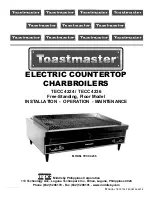
25
VI: SYSTEM START-UP (continued)
transition the control to a dedicated
Pump Prime mode, during which the
motor, igniter, and valve are powered for
four (4) minutes. The yellow light will be
on.
• At the end of four (4) minutes, the yellow
light will turn off and the control will
automatically return to standby mode.
iii.
Limited Recycle:
This feature limits the
number of recycle trials (for each call
for heat) to a maximum of three trials. If
the flame is lost three times and does not
successfully satisfy a call for heat, the 7505
locks out.
iv.
Limited Reset (Restricted Mode):
In order
to limit the accumulation of unburned oil in
the combustion area, the control can only be
reset three times. The reset count returns to
zero each time a call for heat is successfully
completed.
v.
T-T Jumper: Select models have pre-installed
T-T jumper.
DO NOT
remove jumper.
Note:
DO NOT
remove "T-T" jumper
unless
wiring diagram indicates a direct
connection from thermostat and/or tankless
heater aquastat control to the oil burner
primary control's "T-T" terminal. Refer to
appropriate wiring diagram, see Figure 6.
vi.
Diagnostic LED: The indicator light on oil
primary control provides lockout, recycle and
cad cell indications as follows:
•
Flashing at 1 Hz (½ second on, ½ second
off): system is locked out or in Restricted
Mode.
•
Flashing at ¼ Hz (2 seconds on, 2 seconds
off): control is in Recycle Mode.
•
On: cad cell is sensing flame.
•
Off: cad cell is not sensing flame.
vii.
Cad Cell Resistance Check
:
For proper
operation it is important that the cad
cell resistance is below 1600 ohms. During
a normal call for heat, the cad cell leads
can be unplugged from the control and the
resistance measured with a meter in the
conventional way.
Conduct these tests with flame present, see
chart below.
Flame Detection Range
Normal (0 - 1600 ohms)
Limited (1600 ohms to lockout)
3. CHECK OIL PRIMARY CONTROL
CAUTION
Due to the potential hazard of line voltage, only a
trained, experienced service technician should
perform the following safety checks.
This control contains no field-serviceable parts.
DO NOT attempt to take it apart. Replace entire
control if operation is not as described.
a.
Preliminary Steps
•
Check wiring connections and power supply.
•
Make sure power is on to the controls.
•
Make sure limit control is closed.
•
Check contacts between ignitor and the
electrodes.
•
Check the oil pump pressure.
•
Check the piping to the oil tank.
•
Check the oil nozzle, oil supply and oil filter.
b. Check Safety Features
Safe Start:
•
Place a jumper across cad cell terminals.
•
Follow procedure to turn on burner. Burner
must not start, indicator light turns on and
control remains in Idle Mode.
•
Remove jumper.
c. Simulate Ignition or Flame Failure:
•
Follow procedure to turn on burner.
•
Check cad cell resistance. If resistance is
below 1600 OHMS and burner runs beyond
safety cut-out time, cad cell is good.
•
If safety switch shuts down burner and
resistance is above 1600 OHMS, open line
switch to boiler. Access cad cell under ignitor,
clean face of cad cell and see that cell is
securely in socket. Check gasket around
perimeter of ignitor lid for proper seal. If
gasket is missing or damaged, replace gasket.
Room light can effect cad cell resistance. Reset
safety switch.
•
Close line switch to boiler. If burner starts
and runs beyond safety switch cut-off
time, cell is good. If not, install new cell.
•
Close hand valve in oil supply line.
•
Failure occurs, device enters Recycle Mode.
•
Device tries to restart system after
approximately 60 seconds.
















































